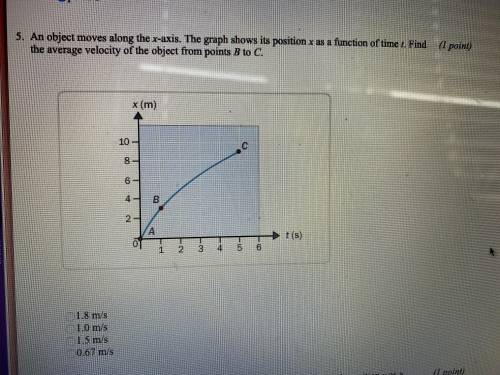
Physics, 20.09.2020 16:01 TravKeepIt100
An object moves along the x axis. The graph shows it’s position x as a function of time t. Find the average velocity of the object from points B to C.


Answers: 1


Other questions on the subject: Physics

Physics, 22.06.2019 02:50, lilybear1700
Steam is generated in a boiler of a cogeneration plant at 10 mpa and 450°c at a steady rate of 5 kg/s. in normal operation, steam expands in a turbine to a pressure of 0.5 mpa and is then routed to the process heater, where it supplies the process heat. steam leaves the process heater as a saturated liquid and is pumped to the boiler pressure. in this mode, no steam passes through a condenser, which operates at 20 kpa. (a) determine the power produced in the turbine and the rate at which process heat is supplied in this mode. (b) determine the power produced in the turbine and the rate of process heat supplied if only 60 percent of the steam is routed to the process heater and the remainder is expanded to the condenser pressure. (3.32 mw; 9.69 mw; 4.25 mw; 5.82 mw)
Answers: 3


Physics, 22.06.2019 18:30, raywalker3410
Adisk with a radius of r is oriented with its normal unit vector at an angle q with respect to a uniform electric field. which of the following would result in an increase in the electric flux through the disk? check all that apply? a. increasing the area of the disk b. decreasing the given orientation angle of the disk c. decreasing the strength of the electric field d. increasing the given orientation angle of the disk, but not exceeding an angle of 90
Answers: 1

Physics, 22.06.2019 19:30, rprest00
Amass m = 74 kg slides on a frictionless track that has a drop, followed by a loop-the-loop with radius r = 18.4 m and finally a flat straight section at the same height as the center of the loop (18.4 m off the ground). since the mass would not make it around the loop if released from the height of the top of the loop (do you know why? ) it must be released above the top of the loop-the-loop height. (assume the mass never leaves the smooth track at any point on its path.) 1. what is the minimum speed the block must have at the top of the loop to make it around the loop-the-loop without leaving the track? 2. what height above the ground must the mass begin to make it around the loop-the-loop? 3. if the mass has just enough speed to make it around the loop without leaving the track, what will its speed be at the bottom of the loop? 4. if the mass has just enough speed to make it around the loop without leaving the track, what is its speed at the final flat level (18.4 m off the ground)? 5. now a spring with spring constant k = 15600 n/m is used on the final flat surface to stop the mass. how far does the spring compress?
Answers: 3
You know the right answer?
An object moves along the x axis. The graph shows it’s position x as a function of time t. Find the...
Questions in other subjects:


Mathematics, 20.01.2021 21:20



English, 20.01.2021 21:20

Mathematics, 20.01.2021 21:20

Chemistry, 20.01.2021 21:20



Mathematics, 20.01.2021 21:20



